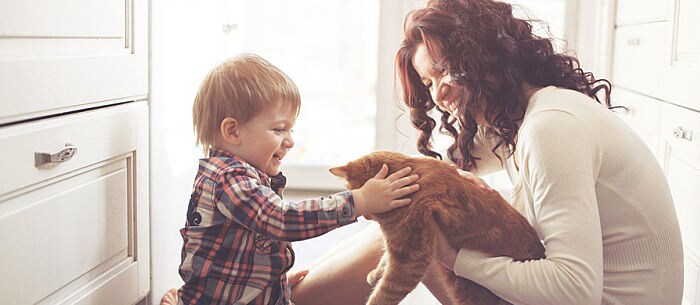At last count, you’ve watched about 876,000 “cute cat playing with adorable toddler” videos. But if your current bundle of joy meows and has whiskers and you’re expecting a baby, you’re probably not 100 percent certain that cats and babies really can coexist in harmony — especially after hearing those scary warnings about a cat stealing a baby’s breath.
While your fur baby will always own a piece of your heart, safety is paramount when the new (human) baby arrives. Experts say you can keep cats and babies happy with some planning and patience. Here are some go-to tips for introducing a cat to your baby from Carol Wilbourn (a.k.a. The Cat Therapist) and veterinarian Dr. Claire Ojala of South Loop Animal Hospital.
- Start with Kitty’s Health
“Cats experiencing illness or pain have a harder time adjusting to change,” says Dr. Ojala, who recommends a pre-baby trip to the vet. “Talk about your cat’s lifestyle and consider keeping the cat indoors, to minimize exposure to toxoplasmosis,” she says. If you’re worried about parasites and diseases, it’s a good idea to wear gloves or have someone else clean the litter box.
- Prepare Your Fur Baby
New parents can help ward off cats biting or scratching to get attention by preparing the animal for the big change several months in advance. “Cats are creatures of habit, so changes, especially a decrease in time spent with loved ones, may be stressful,” says Dr. Ojala.”Changes in furniture or your cat’s sleeping, eating and kitty litter place should be done months ahead.”Because cats are also hypersensitive to scents and sounds, Wilbourn recommends you “introduce baby smells into the home by wearing talcum powder and baby lotion to help your cat associate these scents with something loving.”Some parents worry that the scent of milk will attract their cat to their baby’s mouth. That is an old wives tale, so let that one go — you have enough real worries to deal with! Even though you’ll be hearing plenty of baby cries soon enough, playing a CD of baby crying sounds can help your cat adjust to these new noises. Set up the moving, noisy baby objects, such as the baby swing, in advance and play with your cat near them. These things should do the trick to help your cat feel more comfortable.
- Give Your Cat Lots of Attention
Create a routine that your cat can look forward to every day, provided you can continue with it once baby comes, to ease the transition. For example, you might try rolling a ball while brushing your teeth or dangling yarn during a quick cup of coffee.
- Now That the Baby’s Home
“It’s a good idea to provide something for your cat to be interested in the first day together, like a new scratching post. You can also bring in a cat sitter,” recommends Wilbourn. “Keep acknowledging your cat by talking him while you’re engaging with your baby. Do this by saying ‘You’re so good’ and the kitty’s name over and over. Don’t be afraid to overdo it, especially at first,” adds Wilbourn, who also recommends having an escape place set up for the cat, such as a tree perch.
- Handling an Anxious Cat
It’s impossible to know ahead of time how upside down your household may become once a new baby is part of the mix. Despite your best efforts, your cat may become anxious. “There are only so many ways cats can tell you they’re upset,” says Wilbourn. “They may stop eating, eat too much, become destructive, become aggressive or not use the litter box. Cats go out of their way to tell you they’re upset and are saying, ‘Hey, I need your help.’ Acknowledge them, keep them connected and these negative behaviors should dissipate.”
- Promoting Best Buds
Never force the baby and cat to be together. Always remember that a cat is an animal and that animals can attack when provoked. “When the baby is relaxed, wait for your cat to approach and use treats as enticements,” suggests Dr. Ojala. Reward cats for their interest in the baby, and make sure they can decide when they’ve had enough,” she adds. Cats can be protective of babies, but leaving them alone together is best avoided, especially when the baby is old enough to grab kitty’s tail but too young to realize it hurts.
The cat will be yowling, the baby will be crying and you’ll realize you’re out of litter or diapers. This and so many things about your wonderfully crazy new life will be challenging. Take a deep breath, try to get rest (at least a little) and keep letting both your baby and your cat know that you love them.
Corey Kagan Whelan is a freelance writer specializing in all things mom. Her 12–year old cat, Zoey, survived only a minor amount of tail pulling when her twins were born.


